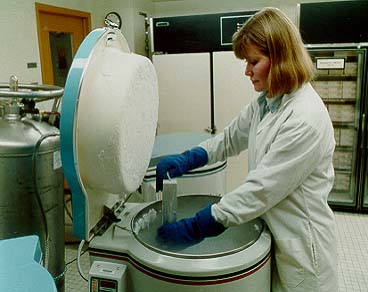|
|
|
| WELCOME: | |
|
Forest Products Laboratory One Gifford Pinchot Drive Madison, Wisconsin 53726 (608) 231-9200 Contact Us... |
|
| You are here: home > > research work units > rwu4501 > culture collection |
Center for Forest Mycology ResearchFS-FPL-4501
The Reference Culture Collection at the Center for Forest Mycology Research is one of the largest assemblages of primarily Basidiomycetous fungi in the world, containing about 12,000 isolates representing about 1,500 species. Approximately 3,500 cultures are haploid isolates. Mycologists at CFMR continuously collect new cultures of wood decay fungi as they conduct research on fungal biodiversity throughout the world. These fungi are brought back to the Forest Products Laboratory and identified by experts who specialize in particular groups of organisms (i.e. corticioid fungi, polypores, and agarics). Cultures of the freshly collected fruiting bodies are made from spores, fungal tissue, or both. DNA can be extracted from the living cultures and studied using techniques from molecular biology. Polymerase chain reaction (PCR), restriction fragment length polymorphisms (RFLPs), and DNA sequencing are used to study the relationships among and between groups of fungi. Haploid cultures are used in crossing experiments to learn about the genetics of the fungi. Information about the cultures is catalogued in an electronic database. Cultures are then frozen under controlled conditions and maintained in liquid nitrogen to minimize genetic change and maximize longevity. A second set of "working" cultures is maintained at 4 C in sterile distilled water. The Culture Collection Catalogue can be searched by clicking here: The fungi in the culture collection serve many purposes:
How to Obtain Cultures: Small numbers of cultures are given to researchers at no charge as a professional service. Industrial users are encouraged to purchase equivalent cultures through the American Type Culture Collection; we do not compete with private concerns. In some situations, we have entered into collection agreements with pharmaceutical companies that were interested in screening large numbers of our cultures to locate organisms with unique medicinal or biotechnological properties. Such agreements are still available. Please contact Daniel Lindner (608-231-9511), Culture Collection Director, to obtain or deposit cultures in the CFMR culture collection. |
| Important Notices | FOIA | Privacy Notice | Quality of Information | Site Map | Site Help |

 Culture Collection
Culture Collection